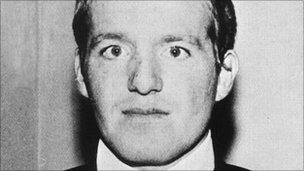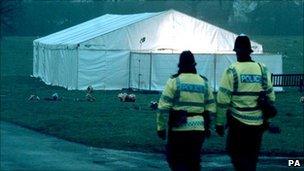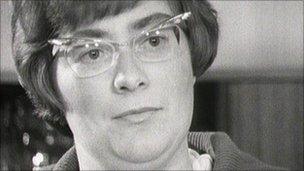50-year fight to clear James Hanratty's name
- Published

Politicians, pop stars and legal experts joined the Hanrattys' fight to get his conviction overturned
James Hanratty went to the gallows protesting his innocence, and asking his family to clear his name.
He was hanged on 4 April, 1962 at the age of 25 and was one of the last people to die before the abolition of capital punishment.
It all began one night the previous August in a cornfield at Dorney Reach, in Berkshire.
Inside a parked Morris Minor was a 36-year-old scientist, Michael Gregsten, and his 22-year-old girlfriend, Valerie Storie.
They were confronted by a man with a gun. He ordered them to drive to Deadman's Hill, on the A6 near Bedford.
With the car parked in a lay-by, Michael Gregsten was shot dead. Valerie Storie was raped, shot five times and left for dead.
She survived, but was paralysed from the waist down.
Hanratty, from north London, was arrested, tried and convicted of murder. The jury did not believe his story that he was 200 miles away at the time of the attack.
But the case became a cause celebre, with politicians and pop stars, legal experts and writers joining the campaign to prove he was the victim of a miscarriage of justice.
After a lengthy campaign, the family of James Hanratty finally made a breakthrough in June 1999 when the Criminal Cases Review Commission agreed to send the case to the Court of Appeal.

James Hanratty's body was exhumed so a DNA sample could be extracted from his remains
But what happened in the months after that re-opened the controversy.
The Crown took advantage of modern DNA profiling to carry out new tests on the exhibits in the case.
The mother and brother of James Hanratty both provided samples of DNA to enable a comparison to be made with traces of DNA found on Valerie Storie's underwear and a handkerchief wrapped around the murder weapon.
The comparison showed a match. Lawyers for the Crown told the Court of Appeal that this was strong evidence - the DNA was two and a half million times more likely to belong to Hanratty than anyone else.
But to put the matter beyond doubt, they needed to extract a sample of DNA from his remains, buried in a Hertfordshire cemetery.
The Court of Appeal did not have the power to order an exhumation.
But the Lord Chief Justice, Lord Woolf, said it would be desirable "in the interests of justice" and in March 2001, DNA sample extracted from Hanratty's exhumed body was matched by forensic experts to two samples from the crime scene.
The DNA evidence was seized on by those who believed that Hanratty was the A6 killer.

Valerie Storie said she had "absolute" belief in Hanratty's guilt
And the Crown's lawyers used it to try to convince the Court of Appeal that the conviction was safe.
In a statement issued through the police, Valerie Storie said the new evidence supported her "total and absolute" belief in Hanratty's guilt.
And within the police, there were hopes that it would finally draw a line under a case that has been argued about for 40 years.
But despite what appeared to be a setback for their campaign, the family of James Hanratty said they were still confident that the appeal would prove he was wrongly convicted.
Their lawyers argued that the DNA tests proved nothing, because of a real possibility that evidence gathered in 1961 had been contaminated.
They said the latest techniques were so sensitive that they require police exhibits to be handled according to strict procedures.
The family's lawyers argued that the prosecution case had been "fatally flawed" by revelations that crucial documents were withheld from the defence.
They said the documents showed that evidence used to identify Hanratty as the killer was flawed.
On the eve of his execution, Hanratty told his family: "I'm dying tomorrow but I'm innocent. Clear my name."
Now, nearly 50 years on, his family plan to make a case to the Criminal Cases Review Commission for a new appeal to be heard in the Court of Appeal.
They will argue that DNA testing is fallible and Hanratty's samples were contaminated.
- Published30 December 2010